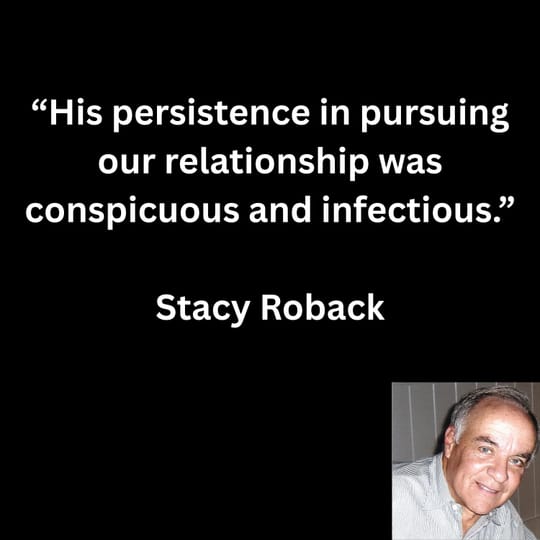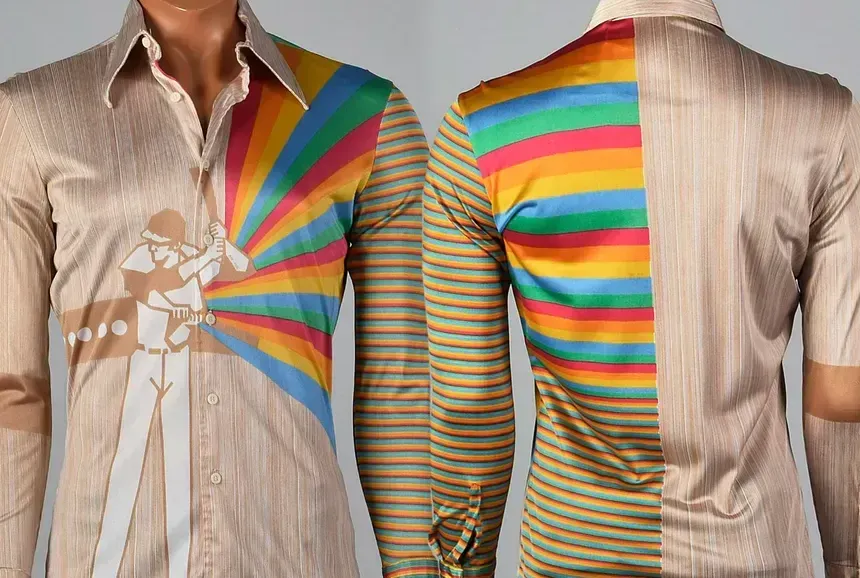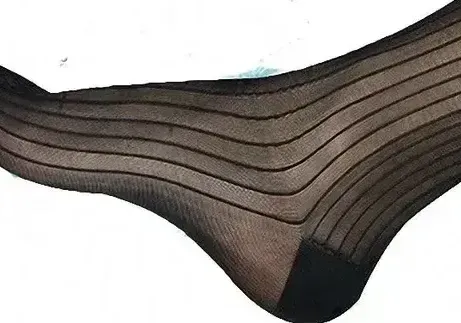
Stacy Roback and Tom
Having finally ditched cigarettes, booze, pot, and partying, I left my job at the IDS Center after the accident to focus on school. I started working part-time delivering furniture at Thomas Designs, a very high-end, expensive furniture store. Little did I know I would meet someone who would determine the entire trajectory of my life, for the rest of my life - Stacy Roback.
Stacy was a pediatric surgeon in Minneapolis who had just finished his surgical residency and was now on staff at Minneapolis Children's Hospital. He and his wife, Donna, had three kids and had built a new home, which they were outfitting with furniture and custom-made pieces from Thomas Designs. I became a regular at their new home while delivering and installing their new furniture.
I don't recall the specific moments or interactions that led me to come under Stacy's spell. He had this gentle, curious, accepting aura about him that could disarm anyone and make them feel seen and psychologically safe. Plus, nothing seemed to rattle or upset him, ever. Stacy appeared to float on a magic carpet of grace with a gentle wit and kindness that made anyone who knew him love him. Plus, as I came to learn, he was a master surgeon.
Somehow, I must have piqued Stacy's curiosity since he soon took an interest in me and my past. Before long, I found myself going over to his house and hanging out with him and his family. Over time, I came to know his wife, Donna, and their young kids, and discovered that I loved playing with them, especially their daughter, Stephanie.
As I would come to understand later, when I was a surgical resident and then a surgeon, daytime naps were heaven. I could, and still can, take a 10-minute nap nearly anywhere at any time. So could Stacy, and I would typically visit on a Sunday afternoon, sitting in a chair in the TV room while Stacy reclined on the Italian leather couch as we watched the game of the week. Most of the time, it was me watching the game, while Stacy slid in and out of his nap reverie.
Stacy must have seen something in me over time, because he took me under his mental wing and offered gentle suggestions and guidance as I struggled along in school. He never told me what I should do or need to do. He had a remarkable way of suggesting something indirectly and with a gentle touch, and because I liked and respected him with all of my heart, his words and suggestions became a divining rod for finding my future.
When I met Stacy, I had completed one year of school at Metropolitan Junior College and had been admitted to General College at the University of Minnesota. General College was, thankfully, a way station for kids from the other side of the tracks to get on a new track to gain admission to one of the "real" colleges at the University, like the College of Liberal Arts.
I had made great progress: I had obtained my GED, completed a year of community college, and now I was knocking on the door of becoming a real University student and gaining admission to the College of Liberal Arts. Mission accomplished, but I had no idea what to major in or what direction to take. One day, while I was sitting in the chair next to Stacy, who was supine on his Italian leather couch, drifting in and out of consciousness as we watched the football game, he suggested that I check out the vocational testing center at the University.
I'm not sure why, but Stacy's suggestion is a moment in time I will never forget. I had never heard of such a thing, and it seemed like it could be a lifeline to help pull me out of the vast ocean of choices and indecision that was threatening to drown me. One feature of mine that has always been present, no matter the circumstances, is my willingness to give things a try, even if they seem far-fetched or out of reach in the moment.
So I signed up, met with a counselor, and took a raft of tests. One test in an instant changed my life. The results were displayed on a graph: on the x-axis was a long list of various jobs, and on the y-axis was my score for each of the jobs along the x-axis. The higher the score for each job, the more likely it was to be a good fit.
My scores for virtually all of the jobs on the x-axis were at the bottom of the y-axis - a long straight line of dots across the bottom of the page (remember, no computers yet) except for two: physical therapist and physician. The physical therapist's dot was many inches above the long line at the bottom of the sheet, but the physician's dot was way up in the clouds above the physical therapist's dot. Looking at the physician dot so high up on the y-axis felt like I was standing on the x-axis looking up at the peak of Mount Everest.
Mount Everest looked beautiful, but the idea of finding a way to summit the mountain and get into medical school seemed preposterous. So, I figured I would give the physical therapy thing a try, even though I had no idea what a physical therapist was.
My assigned college counselor suggested that I sign up to volunteer at the Children's Rehab Center at the University and start taking the required beginning science classes needed to apply to physical therapy school. To give you an idea of where I stood on the science knowledge scale, I had to start with Math 0009 in General College, a rigorous academic course focused on advanced mathematical concepts, such as adding two fractions by finding a common denominator.
Context is again important: one can think of my time up to then in terms of mini eras. The first era was as a juvenile delinquent lost in a sea of anger, resentment, and loneliness that, in concert with my particular personality, led to a staggering degree of impulsivity and risk-taking.
Era two was the Navy, which was a period of transition. When I hit boot camp in San Diego, I had been smoking cigarettes for four years, smoking bales of marijuana, taking LSD and speed, drinking alcohol like a fish, and had never exercised a day in my life except to run from a cop.
Although bootcamp was a jarring transition and difficult - physically and mentally - the shock of transitioning from total wild free agent every day to being told what to do every minute of every day was massive - but I loved it, because I finally had some structure, a meal three times a day, and I couldn't get away with anything. After boot camp, I was assigned to the USS Hancock, a World War II vintage carrier that was in dry dock when I joined it. Being on an aircraft carrier was one of the coolest experiences of my life, but it was during the Vietnam War. Drug use was rampant on the ship, so I regressed back toward the mean of my previous behaviors, but not so much as to destroy my time in the Navy.
Era three is after the Navy. My mindset was in transition. The combination of working at Thomas Designs and being exposed to the world of fancy living combined with Stacy and Donna taking me in as a human being with care and love allowed me to start to wake up from the programming of my past and the way I saw the world and start to see the light of a different way of living and thinking.
But here's the thing: it takes time and muscular patience with ourselves to shed the past and our old identities and programming of our parents and our old ways of thinking, especially when you don't feel even vaguely close to being worthy enough or smart enough or whatever enough to warrant entry into another world. I had a nearly life-threatening case of Imposter Syndrome that threatened to kill my progress day in and day out.
One thing of my past which I clung to like a needy boyfriend during the transitions through my eras was my style of dress established during my later teen years: cool guy with silky Nik Nik shirts emblazoned with wild designs,

pieced together with a short and tight deep maroon leather jacket with thick black masculine zippers, jeans, and a pair of Florsheim loafers accented with a pair of these nylon ribbed socks. 🫣

I lived in south Minneapolis and, having totaled my Chevy Vega that I worked for a year to buy and nearly killed myself, I once again found myself taking the bus. On my very first bus ride to the University, the bus filled up with more and more University students, none of whom were dressed in my comical Minnesota State Fair-like cool guy outfit.
My mental world contracted inwards like a turtle into its shell with searing shame and embarrassment. My hand started to reach up to pull the cord and ring the bell, so I could let myself off at the next stop and run away, a pattern of behavior well ingrained in me during my teenage years. I hesitated, dropped my hand, and decided to gut it out and put one foot in front of the other.
So, I was in transition from being an ex-cool guy delinquent to becoming a University student when I went to my first day of volunteering at the Children's Rehab Center. I met with Cheryl, the physical therapy boss, who assigned me to feed a young boy named Tom at lunchtime.
Tom was 10 years old and had severe cerebral palsy and was confined to a wheelchair with his arms and legs strapped in because of their uncontrolled spastic movements. His head bobbed around on the top of his strapped-in body like a boxer avoiding endless jabs to the head, and when he talked, he sounded like I must have sounded when they dragged me into the hospital in a drunken stupor after my Vega accident.
The situation seemed like a disaster. Not only did I feel as if I didn't belong at the University, but there was no way in hell I was going to be able to pull off feeding some kid like this at lunchtime. But as I was starting to learn, and I mean really learn, just like on the bus, that escaping would bring me freedom and relief in the moment, but that sweet taste of mental freedom would take me exactly nowhere, except back to the shitty baseline of my past.
I could not accept that, so I had no choice but to keep moving forward, one foot in front of the other.
My first day of feeding duty was a nightmare. They parked Tom at the table with a couple of other wheelchair bound kids across from us, and I was instructed on the feeding protocol. Tom's tongue was as thick as a small boa constrictor, and at lunch time, it must have been a sign of food excitement because it kept coming out of its oral cavity hiding place and thrashing around on the left side of his face before retreating back in. Plus, despite his mechanical limitations, Tom was chatty as hell, so his lips were in constant motion as he tried to talk to me, and the more he tried to talk, the more animated he became, and the more the rest of his out-of-control body wiggled and thrashed around.
The tongue and lip situation presented a significant technical issue in my endeavors to feed Tom efficiently. Given his boa constrictor tongue and the relentless movement of his lips, his meals were composed entirely of soft, mushy, baby-food-like food. I used a small spoon to feed him as the technical challenges made the insertion of any normal volume of mush impossible since it just squirted out from all the tongue and lip mayhem.
I did get the hang of it pretty quick though and discovered that if I timed the insertion of the small spoon of mush to occur just as his boa-like tongue retreated back into his cave I could angle the spoon's trajectory to insert the mush into the right side of his mouth. Using this technique, I could get up to about 75% of the mush to stay put in his mouth.
Despite my persistent efforts to get it all to stay put, I soon had to accept the fact that I would never succeed in getting the whole spoonful to stay in, so I learned to deploy the spoon immediately after mush insertion to scrape up the mush that squirted out of his mouth and down the right side of his chin.
Insert, scrape up, reinsert, scrape up, reinsert, scrape up until 100% of the spoonful was on its way down to the acidic cauldron of his stomach.
As I write this I realize, once again, that just like my vacuuming situation, my efforts to master mush management in Tom was a signal, a premonition if you will, for my future love of creating a system for anything - from organizing the dishwasher to mastering every step of an operation to the point of being able to do it without thinking. Of course, at the time, I was in the dark about myself and what made me "tick," but I have learned how important these seemingly irrelevant signals are to discover what can fulfill you in life and make you shine.
So the small gift of insight about my love of systems went unnoticed, but there was a bigger gift that Tom gave me that transformed how I thought of myself: he opened my heart.
I fell in love with the little goof. Over time, I learned to read his movements and even understand a good bit of what he was trying to say. Plus, even with what I thought was an unmitigated nightmare of an existence, Tom loved to laugh and goof around, and when he got going, so did his whole body, as if he was dancing with his arms and legs twitching and his lips and tongue going at it in a great big full-body spasm of joy.
I became so attached to him that I started going over on some afternoons (of my own volition!) to take him outside on walks, with me in my Nik Nik shirts and maroon jacket, and him strapped in like a fighter pilot as we took off down the street together, in front of everyone. It was one of the first times when I stopped caring what anyone might think about me. Two humans from two wildly different worlds, brought together by the power of our lives' fortuitous concatenations in an overlapping Venn diagram of connection, care, and love.
Stacy and Donna had a profound influence on my young life at exactly the time when I was in a Twilight Zone time of my life: in between the hell and chaos of the past and the bright future I had no idea was waiting for me. I owe that bright future, and frankly everything that has unfolded over my life, to the booster rockets of Stacy and Donna's support, acceptance, love, and belief in me.
Stacy and I were featured on a segment of the PBS series This Emotional Life if you would like to meet him and see just how special he was (the clip starts at 1:37:36). And if that weren't enough, one of the greatest moments in my life was when, years later, as a thoracic surgeon at the University, Stacy asked me to help him at Children's with a complicated thoracic surgical case. Talk about Fortuitous Concatenations! It was thrilling to be in the operating room with my friend, my relentless supporter, and a master surgeon.
